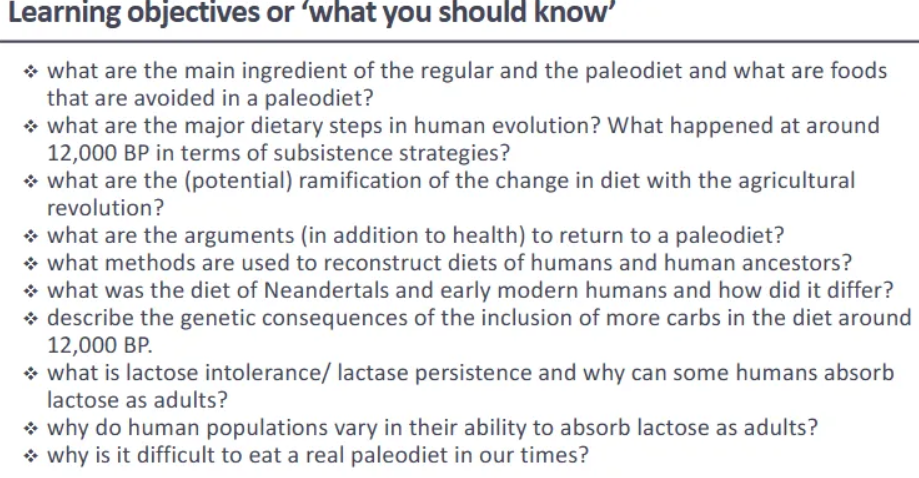ANP 220: paleo-diet/fantasy diet 11
1/32
There's no tags or description
Looks like no tags are added yet.
Name | Mastery | Learn | Test | Matching | Spaced |
|---|
No study sessions yet.
33 Terms
Chronic disease incidence
- modern western populations often characterized by frequent
- cancer
- cardiovascular disease
- high-risk cholesterol
- obesity
- hypertension
- osteoporosis and osteopenia
ramification of an unhealthy diet
- too much refined grains and sugar
- too much saturated fatty acids and trans fatty acids
- too much simple carbohydrates versus to low protein → coronary heart disease
- low density of vitamins and minerals → vitamin deficiency
- too much acidic foods → promoting osteoporosis
- too much sodium versus potassium → hypertension
- too little fiber-rich foods → constipation
paleodiet regular/wester diet
- carbs(grains) with some fruits/veggies/meat/dairy
- small amounts of fat and sugar
- carbs and dairy
- generally, part of the diet that healthy and natural
paleodiet
meat with some fruits and veggies
some nuts and berries
carbs and dairy
avoid-unhealthy and unnatural
major events in human evolution: ca. 7.0-3.5 million years ago
- early hominini; some australopithecines
- mostly(forest) fruits, leaves
- meat (little, if any)
major events in human evolution: ca. 3-5-2.5 million years ago
- late australopithecines; early homo
- first stone tools
- scavenging and perhaps some hunting
- increased reliance on meat
major events in human evolution: ca. 1.5-0.5 million years ago
- middle homo
- more sophisticated tools
- more hunting
- more eating, some cooking
major events in human evolution: ca. 250-250,000 years ago
- late homo (neandertals and early modern humans)
- very sophisticated tools
- regular hunting
- meat-eating but also mixed diets; regular fire use
major events in human evolution: ca. 12,000 years ago
- modern humans
- agriculture and herding (neolithic revolution)
- more reliance on grains
- at some point dairy products (milk/milk products)
Cardian et al. 2005 AM J Clin Nutr 81
In particular food staples and food processing procedures introduced during the neolithic and industrial period have fundamentally altered nutritional characteristics of ancestral hominin diets
Changes in the Neolithic (and Industrial Period)
- too much refined grains and sugar
- too much saturated fatty acids and trans fatty acids
- too much simple carbohydrates versus to low protein → coronary heart disease
- low density of vitamins and minerals → vitamin deficiency
- too much acidic foods → promoting osteoporosis
- too much sodium versus potassium → hypertension
- too little fiber-rich foods → constipation
Paleoarguments
human ancestors
- hunter-gatherers for more than 2 million years (>65,000 generations)
- agriculture and herding since ca. 12,000 years ago (350 generations
modern human
- not enough time to evolve/adapt
- genetically adapted to hunter gatherer diet
- mind and body still like “cave dwellers”
paleo conclusion
to stay healthy and eat like a caveman
How do we know what hominins ate?
1. Food preparation and remains
- artifacts and animal bones
- plaque on teeth (tartar)
- food particles and microbial DNA
2. physical or chemical signatures
- dental microwear
- stable isotope analysis
- carbon isotope composition
- carbon to nitrogen ratios
3. adaptations
- changes in gene or gene regulation
- related to digestion, enzymes etc
Diet before the agricultural revolution
neanderthals
- high 15N (predator like)
- terrestrial sources
early modern humans
- high 15N (predator-like)
- more marine sources
Caveat: Is there “THE” paleodiet
diet among modern hunter-gatherers
- changes by region; for example
- a lot meat/fish (Inuit, Hiwi)
- intermediate amount of meat (Hadza)
- little meat (!Kung)
→ among early modern humans likely not ALL ate primarily meat/fish
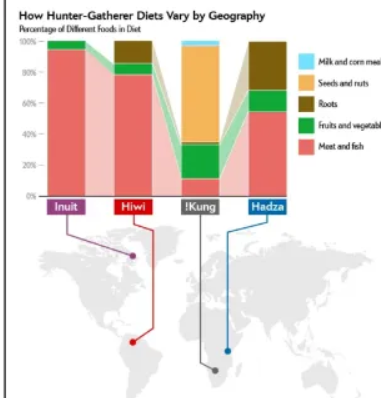
Grains and starches in the diet: ca. 30,000 years ago
- mortar and pestle-type stones
- remains of plant starches
Grains and starches in the diet: ca. 50-30,000 years ago
- plaque on teeth
- remains of cooked and uncooked starch grains (barely)
Grains and starches in the diet: ca. 100,000 years ago
- plaque on teeth
- bacteria (streptococcus with amylase binding capability(=carb digestion)
- both neandertals and early modern human
- common ancestor: 600,000 years ago
Major events in human evolution: ca 250-200000 years ago
- late homo (neandertals and early modern humans)
- even more sophisticated tools
- regular hunting
- meat-eating but also mixed diet; regular fire use
The agricultural revolution
ca. 12,000 years ago
- less climate fluctuation (warmer, wetter, stable)
- domestication of plants and animals
consequences of agricultural revolution
- increase in population size high fertility
- changes in skeleton (diet, workload, activity)
- population crowding and infectious diseases
- reduction in general health
→ why farming, why herding
→ did the human genome change
ability to digest carbs: genetics
- amylase gene AMY1 - amylase break down starch into sugars
- closely related primates = 1 or no amylase gene
- multiplication (multiple gene copies) in people with high carb diet
- high amount of amylase in the mouth (and pancreas - AMY2, more effective breakdown of carbs
- with agriculture: change in diet (more carbs)
- in the last 10,000 yrs: gene duplication, better digestion of carbs
ability to digest carbs: genomics
- genes associated with metabolizing food
- differ depending on where people live and what they eat
- traditional populations not very specialized can digest many types of food
- agricultural people more specialized; can digest fewer types of food
herding animals
across cultures different forms
- meat
- milk or milk products or both
- farm animals (labor)
- other animal products (wool)
ability to digest milk
milk
large amounts of lactose (large sugar)
enzyme lactase
breaks lactose into glucose and galactose
all mammalian infants
produce large amounts of lactase (to digest milk)
lost after weaning - gene for lactase is turned off
In adults milk causes cramps but can digest processed milk
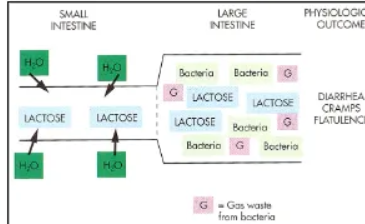
lactase persistence in humans
in some populations adults can drink milk
- called “lactase persistence”
- lactase gene on chromosome #2
- mutation with lactase gene NOT turned off after weaning
- dominant allele
- persists in homo- and heterozygous individuals
- common in populations with history of dairying
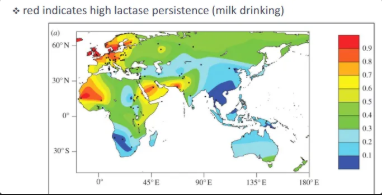
why lactase persistence in humans
- in certain populations mutant alleles increases in frequency via natural selection
possible causes (adaptive benefits)
- provides vitamin D (in northern latitudees
- ‘superfood’ it's just good for you
- uncontaminated source of hydration (particularly in dry areas)
Paleo-arguments versus gene-culture coevolution
paleo-argument
- genetically adapted to hunter-gatherer diet
- not adapted to modern diets with carbs and dairy
gene-culture co-evolution
- change in subsistence strategies ca. 12,000 yrs ago
- carbs and dairy part of (some) humans diets
- genetic adaptations to digest carbs and dairy
- varies among populations with subsistence

where do some of these ingredients originate from
- onions - west-central Asia
- garlic - central Asia
- ginger - south asia
- cinnamon - asia
- pumpkin - America
- coconut milk - Asia
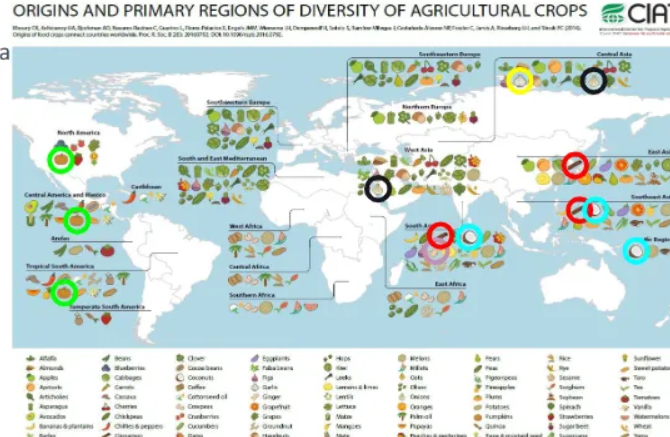
wild versus domesticated plants
with the agricultural revolution
plants and animals (were) changed)
can happen very rapidly
paleoargumants conclusion
human ancestors
- hunter-gatherers for more than 2 million yrs (>65,000 generations)
- agriculture and herding since ca. 12, 00 yrs ago(>350 generations)
adapted to changes in diet
- though we are not adapted to refined sugars, highly processed food, and trans fat
learning objectives
